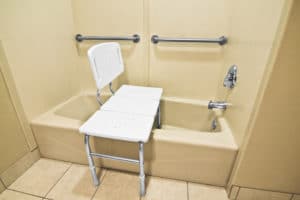When can I shower or take a bath after surgery?
A traditional concept regarding surgical wounds and bathing is that the water touching the wound will increase the rate of wound infection. However, published research demonstrates no increase in the overall rate of wound infections or complications when patients showered as early as 24-48 hours after surgery. The rationale for restrictions to showering and bathing after surgery is related to maceration or weakening of the incision line as it becomes wet and soft, as well as keeping any glue or skin adhesives the physician may have used to the incisions from falling off prematurely. This doesn’t mean avoiding cleaning your body on a routine basis. It means that you should take a sponge bath until you can shower, and avoid soaking the surgical site until the incision is completely healed.
Your surgeon will best determine when it is best for you to shower after surgery as these decisions are directed to your individual circumstances, procedure type, closure technique and site of the surgery. Depending on the type of surgery, plan on waiting anywhere between 24 to 48 hours (or possibly even longer for more serious surgeries) to take a shower unless your surgeon has given you specific instructions otherwise.
Some tips and information regarding showering after surgery:
 -In the immediate post-operative period you will need to keep the dressing/bandage clean and dry.
-In the immediate post-operative period you will need to keep the dressing/bandage clean and dry.
-If you are steady and the physician has allowed for showering with protection of the dressing, be sure to cover the dressing with a waterproof barrier product until your surgeon has determined the dressing may be removed and the surgical site exposed. Commercially available waterproof protectors are available, however do not use a product that adheres directly to the surgical site dressing as it may cause the dressing to become dislodged when removed.
When the surgeon has determined you may shower after surgery:
 -Using a bench or chair in the shower will make showering after lower extremity surgery easier, especially if you are “non-weight bearing” after surgery. It may also offer support if you are unsteady.
-Using a bench or chair in the shower will make showering after lower extremity surgery easier, especially if you are “non-weight bearing” after surgery. It may also offer support if you are unsteady.
-Using a handheld shower head will assist in directing the flow of water, but ensure that you do not point the shower head directly at the surgical site. Direct water under pressure to the site may cause trauma and delay healing.
– After the dressings have been removed, let any skin tapes (e.g., SteriStrips) fall off on their own.
-Use gentle soap when washing and treat your incision site with care. Rinse well. Avoid direct spray from the shower to the incision.
-Performing personal hygiene with soap and water washes in the shower are ok, but do not scrub the surgical incision.
What about a bath?
 As previously stated, taking a bath, or soaking of the incision can be too much moisture and weaken the incision site or impact any adhesives the surgeon may have used. If your surgical wound is secured by staples, you will most likely need to wait until your surgeon removes the staples before you take a bath. This typically happens about two weeks after surgery. If you have any gaps in your incision, you must wait until they are closed to swim or take a bath.
As previously stated, taking a bath, or soaking of the incision can be too much moisture and weaken the incision site or impact any adhesives the surgeon may have used. If your surgical wound is secured by staples, you will most likely need to wait until your surgeon removes the staples before you take a bath. This typically happens about two weeks after surgery. If you have any gaps in your incision, you must wait until they are closed to swim or take a bath.
-Don’t use a pool, or immerse in lake water, ocean, tub or hot tub until the wound is completely healed.
When in doubt, protect your incision. If you aren’t sure it is safe to shower, take a bath, go for a swim, or hop in a lake, don’t do it – check with your surgeon. In general, if your incision has completely closed you can submerge it in water. The risk is largely present when your incision is still closing, but remember that a prolonged soak can weaken the newly healed tissue.
To learn more about a product indicated for the management of surgical wounds, please visit https://sanaramedtech.com/surgical/celleraterx-surgical/




